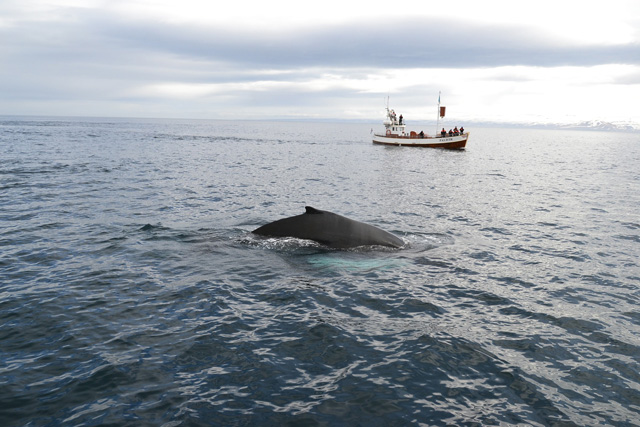If you’ve ever dreamed of seeing whales up close, a whale watching tour in Montauk is an experience you won’t want to miss. Montauk, located at the very tip of Long Island, is one of the best places to spot these majestic creatures in their natural habitat. Before you set sail, let me guide you through what to expect on a whale watching tour in Montauk.
The Start of Your Whale Watching Tour in Montauk
Your whale watching experience will begins at the docks in Montauk. I recommend arriving early so you can check in, get comfortable, and find a good seat on the boat. Most tours last anywhere from 3 to 5 hours, depending on weather conditions and how far the whales are from shore. Montauk boat tours are well-organized and led by experienced captains and marine naturalists, so you’ll feel safe and informed every step of the way.
Pro Tip!
Bring a light jacket, even in the summer. It can get chilly out on the open water, especially with the sea breeze.
During Your Whale Watching Tour in Montauk
Once the boat leaves the dock, you’ll head into the open waters of the Atlantic Ocean. Montauk’s location is right along the migratory paths of humpback whales, finback whales, and minke whales. Marine life here is thriving, thanks to nutrient-rich waters, so keep your eyes peeled for playful dolphins, seals, and even sea turtles along the way!
Fun Fact!
Humpback whales, one of the most commonly seen species in Montauk, are famous for their acrobatic breaches. They can launch their entire bodies out of the water, creating an unforgettable splash!
Spotting Whales: What to Watch For
When you’re on a whale watching tour, spotting whales can feel like a treasure hunt on the open sea. There are a number of clues that can alert you to the presence of a whale. Let’s take a look at what to watch for.
Look for Their Flukes and Fins
If you see something large and dark breaking the surface, it could be a whale’s fluke—its massive tail. Whales lift their flukes high into the air when preparing for a deep dive, and it’s one of the most breathtaking sights you can witness. Humpback whales, in particular, have long, dramatic flukes that are often visible when they’re diving. If you’re lucky, you might even catch a glimpse of their pectoral fins (flippers) waving as they roll on the surface.
Watch for Surface Activity
Whales are full of surprises! Sometimes they perform behaviors that are impossible to miss:
- Breaching: When a whale leaps almost completely out of the water and crashes back down, it’s called breaching. This is an incredible display of their strength and agility. It’s also one of the most exciting things to see on a tour.
- Tail-Slapping: You might see a whale lift its tail and slap it hard against the water. Scientists believe this behavior is a form of communication or a way to scare fish into tighter groups for feeding.
- Lunging: Whales sometimes lunge at the surface with their mouths wide open as they feed. This behavior is common among humpbacks and is an amazing way to see their massive mouths and throat grooves in action.
Pro Tip!
Always scan the water for unusual movement, ripples, or splashes. Whales don’t always stay in one spot, so if you see fish or seabirds gathering, it could mean a whale is nearby, feeding on the same school of fish!
The Guides Make All the Difference
The whale-watching guides onboard are pros at spotting these majestic creatures. They’ll point out the best places to look and help you understand what you’re seeing. For example, guides can often identify the species of a whale just by its spout, fluke, or behavior. Did you know that humpback whale flukes are as unique as human fingerprints? Guides might even recognize certain whales that return to Montauk’s waters year after year.
Fun Fact!
A whale’s blow isn’t just misty air—it also contains water vapor and sometimes mucus. That’s why guides jokingly call it a “whale snot shower” if you get too close!
Pay Attention to Seabirds
Seabirds, like gulls and shearwaters, are often a great clue for spotting whales. Birds tend to follow schools of fish near the surface, and whales aren’t far behind when there’s food to be found. If you notice birds diving repeatedly into the water, grab your binoculars because you might soon see a hungry whale surfacing for a meal.
Stay Patient and Observant
Spotting whales requires a bit of patience. Unlike in movies, whales don’t jump out of the water on command! Keep scanning the water in every direction, and don’t forget to take breaks to enjoy the scenery. The thrill of spotting that first spout or tail is worth every minute of waiting.
Whale watching is as much about the anticipation as it is about the reward. Stay observant, listen to your guides, and enjoy the journey. You’ll have an unforgettable time—even if the whales decide to play hide-and-seek for a while.
Pro Tip!
Pro Tip! If you’re prone to seasickness, take motion sickness medication or wear sea bands before the tour. Staying hydrated and watching the horizon can also help.
What if We Don’t See Any Whales?
Sometimes nature doesn’t cooperate, and there’s a chance you won’t spot any whales during your tour. But don’t worry—there’s still plenty to enjoy while you’re out on the water!
Take in the Scenery
Even without whales, Montauk’s coastline is absolutely stunning. From the gentle waves of the Atlantic to the sweeping views of the horizon, there’s nothing quite like the peaceful beauty of being out at sea.
Enjoy the Marine Life
Whale watching tours often pass through waters teeming with other marine animals. Look closely, and you may see playful dolphins riding the wake or curious seals popping their heads up. Captains and guides usually share interesting facts about the local marine ecosystem, so there’s always something to learn.
Chat with the Crew
The crew on a whale watching tour are usually filled with knowledge and enthusiasm for the ocean. If the whales are shy that day, don’t hesitate to ask questions. They often have fascinating stories about past sightings, marine life behaviors, and even local history. It’s a great chance to deepen your understanding of the incredible ocean environment.
Soak Up the Moment
Being out on the water is a rare and peaceful experience. Take a deep breath, relax, and enjoy the fresh sea air. Bring along a camera or binoculars to look for wildlife in the distance, or simply take in the serenity of the waves. Sometimes, it’s just about being in the moment and appreciating nature’s beauty—whales or no whales.
While whale sightings can’t always be guaranteed, a day spent on the water is still an unforgettable experience. Whether it’s the coastal views, marine birds, or a relaxing escape from “the everyday”, Montauk never disappoints.
The Takeaway: An Experience of a Lifetime
Going on a whale-watching tour in Montauk is more than just a boat ride; it’s a chance to connect with nature and witness some of the ocean’s most incredible creatures. From the excitement of spotting your first spout to learning about the importance of whale conservation, it’s a day you’ll never forget. Whether you’re a first-time visitor or a local looking for an adventure, Montauk offers the perfect opportunity to create lasting memories.
So, pack your essentials, grab your family or friends, and get ready for an awe-inspiring day on the water. You never know what you might see, and that’s what makes it so magical!


